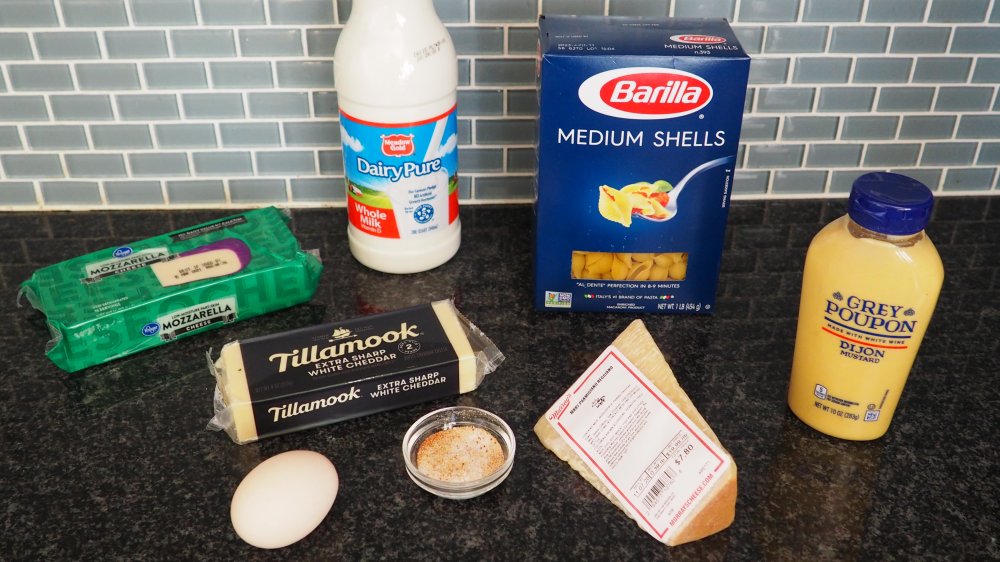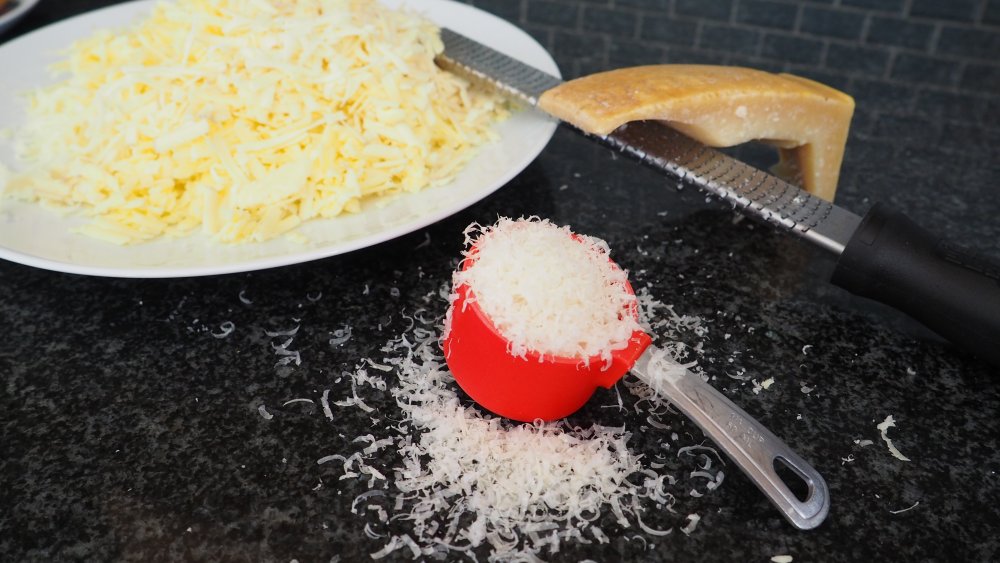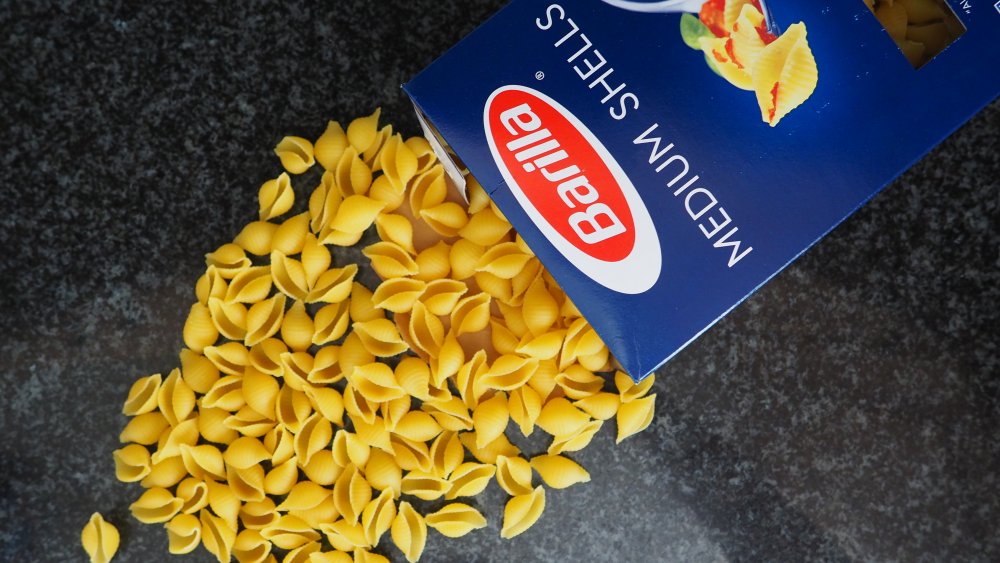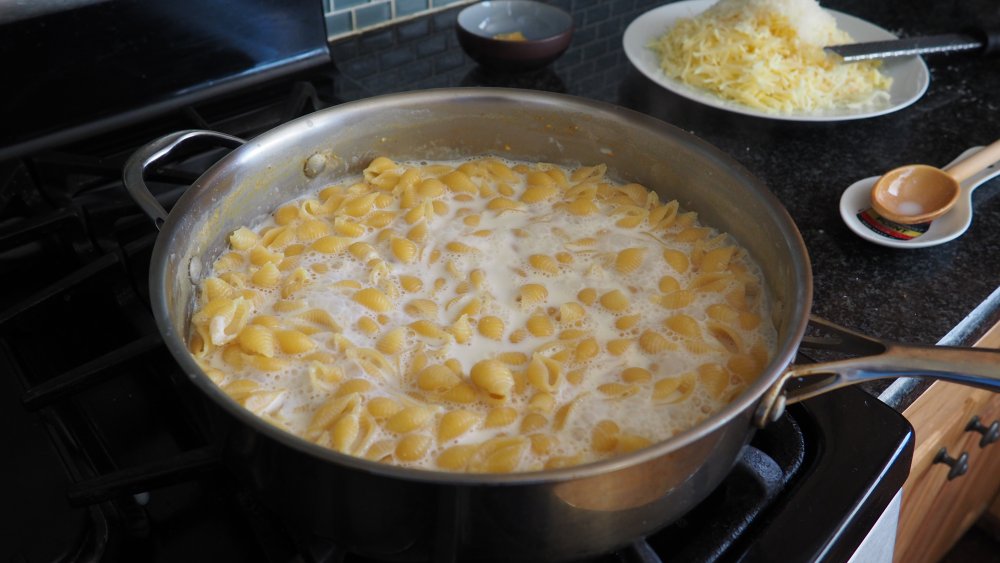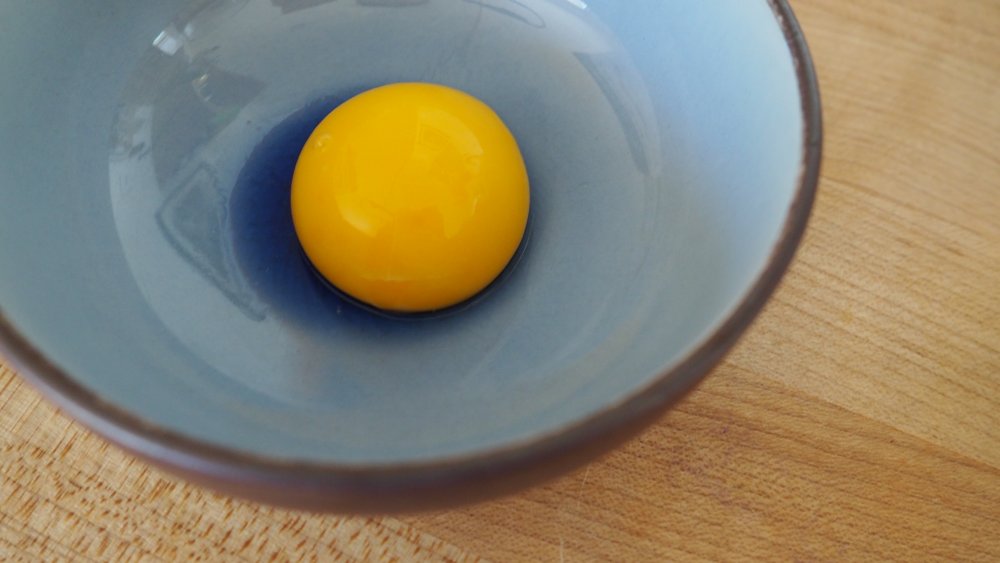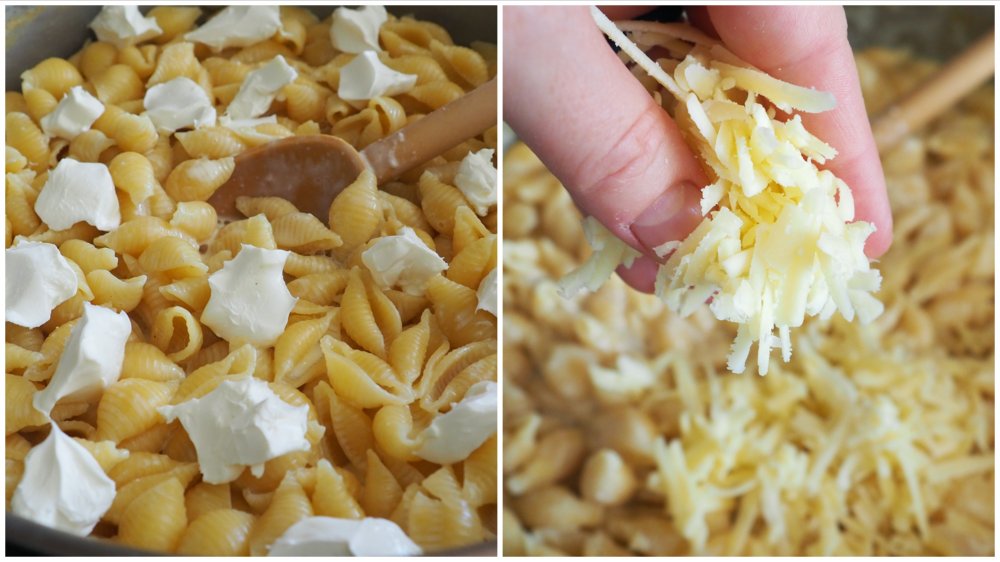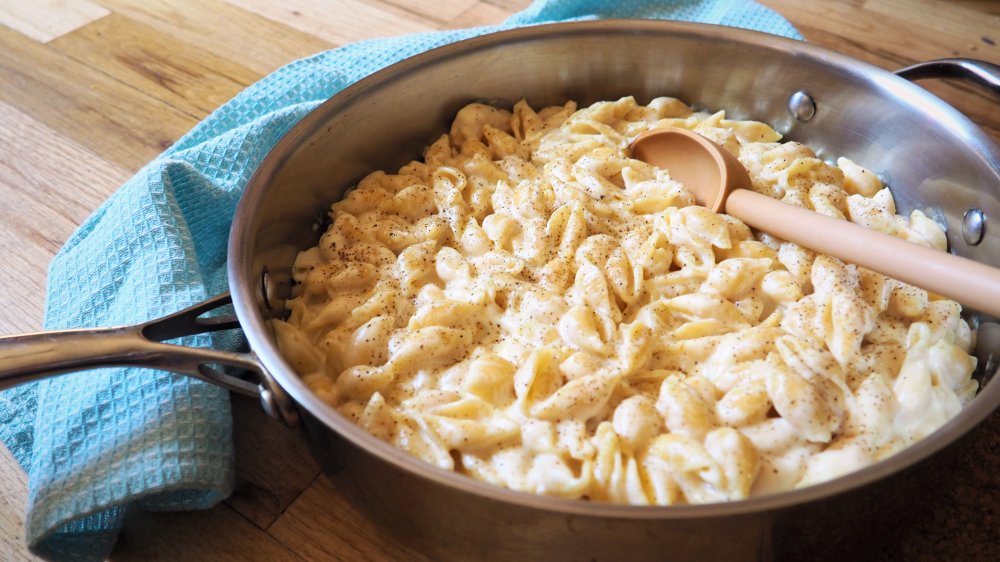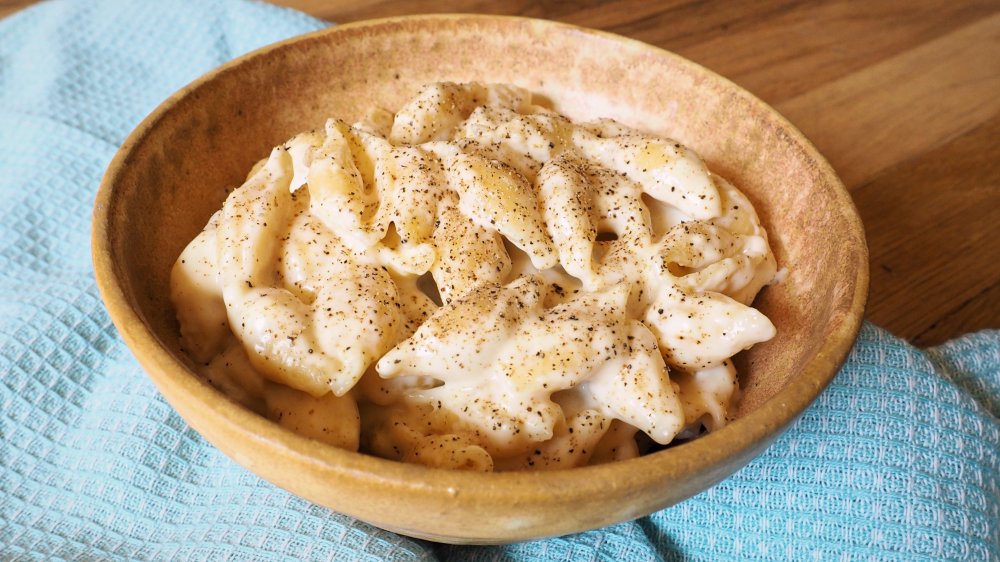One-Pot Mac And Cheese Recipe
When the comfort-food cravings hit, nothing satisfies like mac and cheese. It's soft and creamy, and — when made right — contains a rich flavor that keeps us digging in for bite after bite. Unfortunately, we've all had those mediocre experiences with mac and cheese. It seems like a complicated dish to make, so we end up buying a box of the instant stuff or getting it from the freezer aisle. These quick-and-easy alternatives never turn out quite as good as the dish mom used to make.
Our one-pot mac and cheese recipe is the solution. It's ready in about 20 minutes, and it uses all-natural ingredients that you can feel good about. The best part is that it only dirties up a single pot, so you don't have to worry about washing a boatload of dishes. We don't use any flour to make it, either, so you can easily use your favorite brand of gluten-free pasta. How did we pull it off? Read on to find out.
Gather the ingredients for this one-pot mac and cheese recipe
Our one-pot mac and cheese recipe is remarkably simple. All you need is a quart of milk and a few cups of water. This liquid is the base of the cheese sauce, and it will soon become infused with starchy goodness when it's simmered with a pound of pasta. Cooking the pasta in this liquid (and skipping the draining and rinsing part) also means we don't need to use a roux. The combination of flour and butter is the typical way to start a cheese sauce, so our one-pot method saves time and keeps the ingredients list short!
From there, we also throw a few seasonings into the mix for flavor, namely kosher salt, ground black pepper, garlic powder, paprika, and Dijon mustard. To add richness and help the cheese melt smoothly into the sauce, we also add an egg yolk. This ingredient is totally optional if you don't have any on hand or you have an egg allergy.
Finally, there's cheese: smooth cream cheese, sharp cheddar cheese, melty mozzarella, and flavorful Parmesan. We'll talk about how to make cheese substitutions based on what you have on hand, but it is important to choose a few to create the best flavor.
What is the best cheese for a one-pot mac and cheese recipe?
At its most basic, mac and cheese is just a combination of pasta, milk, and cheese. Considering that cheese is a third of the equation, it's important to put some thought into which ones you'll choose. Most varieties will work here, but it's best to use a mixture of melty and hard cheeses. A mac and cheese made with 100 percent Parmesan just wouldn't turn out quite right, and one made with all cheddar would taste a little bland.
Our one-pot mac and cheese recipe starts with four ounces of cream cheese. You could also use mascarpone if you want to get fancy, but cream cheese has a delightful level of tanginess that adds a subtle flavor to the dish. It also melts smooth and creamy, so the sauce tastes like it was made with heavy cream instead of regular milk.
From there, we add 12 ounces of melty cheeses. We chose sharp cheddar and mozzarella because their flavors pair well together. You don't want to use too much of a super-melty cheese like mozzarella, but two ounces is perfect for adding structure without creating a stringy texture. Other great choices here are fontina, pepper jack, Havarti, and Gruyere.
Finally, the last cheese component is the addition of hard cheese. These cheeses don't melt well, but they contain super-concentrated flavors. A quarter cup of finely grated Parmesan, Romano, Grana-Padano, or manchego works well here.
Which pasta shape should you use for this one-pot mac and cheese recipe?
Classic mac and cheese is made with elbow macaroni. Growing up, that's the only shape we can remember our mothers using, and it's still a great choice today. The grocery store's pasta options have expanded quite a bit over the last few decades, so you don't have to stick with elbows if you want to get fancy.
Most short pasta works here. Short pasta generally refers to pasta that's small enough to be scooped up with a spoon. That could be those classic elbows, shells, cavatappi, or orecchiette. We recommend against using super-small pasta shapes like ditalini or orzo because they don't have ridges. These ridges cling onto the sauce, helping it stick more efficiently (and delivering more to your mouth with each spoonful). We used medium shells for our one-pot mac and cheese recipe because we love how the cheese sauce finds its way inside the shells, loading up for super-cheesy bites.
Of course, you can always select gluten-free brands to make a gluten-free version of this one-pot mac and cheese recipe. You may have to experiment with the amount of liquid used to get it just right. Gluten-free pasta is made from a variety of different grains and legumes, so it may not release as many starches.
Cook the pasta to start this one-pot mac and cheese recipe
When you're ready to get started on your one-pot mac and cheese recipe, grab a large, wide saute pan with tall sides. A saute pan is different from a frying pan: Its sides go straight up inside of flaring out. If you don't have one (or you're not sure if you do), go ahead and use a Dutch oven or large saucepan instead.
Add the milk, water, salt, garlic powder, ground paprika, and uncooked pasta to the pan and heat it over medium-high heat. Wait, you might be thinking, don't I have to cook pasta in boiling water? It's true that most recipes (and the instructions on the box) call for starting pasta in already boiling water, but it's not actually necessary. Serious Eats explains that the water temperature doesn't make a difference to the texture of the finished pasta. Starting the pasta in cold water is more energy-efficient, too, so it's win-win.
When the mixture reaches a boil, reduce the heat so it's barely simmering. Too much heat and the milk can boil over, and we need all that liquid to make our sauce. After eight to ten minutes, the pasta should be al dente.
Why do we add an egg yolk to our one-pot mac and cheese recipe?
We learned an incredible secret when developing a copycat Chick-fil-A mac and cheese recipe: using an egg yolk to make the best cheese sauce. It might seem like an odd ingredient, and it's optional. But this small ingredient goes a long way to creating the right texture and flavor for the perfect cheese sauce.
You see, as cheese releases oil as it melts. Without a starch to latch onto, this oil can become very slick and can cause the sauce to "break." It doesn't ruin the flavor, but it looks unappetizing. That's why most recipes use a little bit of flour, but we don't need it because we're cooking our pasta in the sauce. The starches leech out of the pasta as they cook, infusing the cooking water with everything it needs. The egg yolk is a bit of an insurance policy. It works as an emulsifier, connecting oil and water molecules. That thickens the sauce and helps it bind to the cheese, just in case there weren't enough starches present.
After the pasta is cooked for this one-pot mac and cheese recipe, place the egg yolk and Dijon mustard in a small bowl. Add 1/4 cup of the hot cooking liquid to the yolk, whisking as you add to keep the yolk from scrambling. Add a second 1/4 cup of liquid and whisk to combine before adding the egg-milk mixture back to the pot.
Gradually add the cheese to finish this one-pot mac and cheese recipe
We're almost to the finish line on this one-pot mac and cheese recipe. Hopefully, while the pasta was cooking, you grated all your cheese so it's ready to go. If you haven't done so yet, do it now. You can keep the pasta on a very low flame to keep it warm. We definitely recommend using freshly grated cheese because it melts better. It also doesn't have any strange additives you may find in store-bought shredded cheese, like cellulose (aka, wood pulp).
Remove the pot from the heat and stir in cream cheese. Continue stirring until the cream cheese is melted and the sauce begins to thicken. Working quickly to keep the milk from cooling down, add the grated cheeses one handful at a time. Stir constantly until the cheese is fully melted before adding the next handful of cheese.
When you're finished, assess the consistency of the sauce. If it's too thick, add water or milk one tablespoon at a time until the sauce loosens up. Taste the mac and cheese and season it with kosher salt and ground black pepper, to taste.
How to turn this one-pot mac and cheese recipe into baked mac and cheese
That's it: We're done with our one-pot mac and cheese recipe. It only took about 20 minutes to pull off from start to finish, so you may not be quite ready to serve dinner yet. You can keep the mac warm on the stovetop, or you can cool it down in the refrigerator and reheat it later. If baked mac and cheese is your thing, you can also take things to the next level.
If your saute pan isn't oven-safe, transfer the mac and cheese to a casserole dish. If the sauce looks very thick, go ahead and add extra water until it's thin and runny. Cover the dish with aluminum foil and bake at 350 degrees Fahrenheit for about 30 minutes. Then, uncover the dish and sprinkle the top with breadcrumbs. Add a few pats of butter to the top and bake, uncovered, for another 15 minutes until the top is golden brown.
How did our one-pot mac and cheese recipe turn out?
We served this one-pot mac and cheese to some pretty discriminating eaters, and everyone loved the way it turned out. It was cheesy, creamy, and super rich. The spices were present but not overpowering, and the Dijon mustard combined with the cream cheese to create the perfect level of tanginess. We kept digging in for bite after bite, and the entire bowl was gone before we knew it!
This recipe makes about eight servings, depending on the appetites of your eaters. Each serving contains two ounces of uncooked pasta (or about a cup of cooked pasta). If you end up with leftovers, store them in an airtight container in the fridge for three to five days. Technically, they can be frozen, but we don't recommend it. The pasta will have a mushy texture after it's thawed, so it just won't be the same. Reheat the leftovers on the stovetop or in the microwave, adding a little water or milk to make the sauce creamy again.
One-pot mac and cheese recipe directions
Our one-pot mac and cheese recipe is ready in about 20 minutes, and it uses all-natural ingredients that you can feel good about.
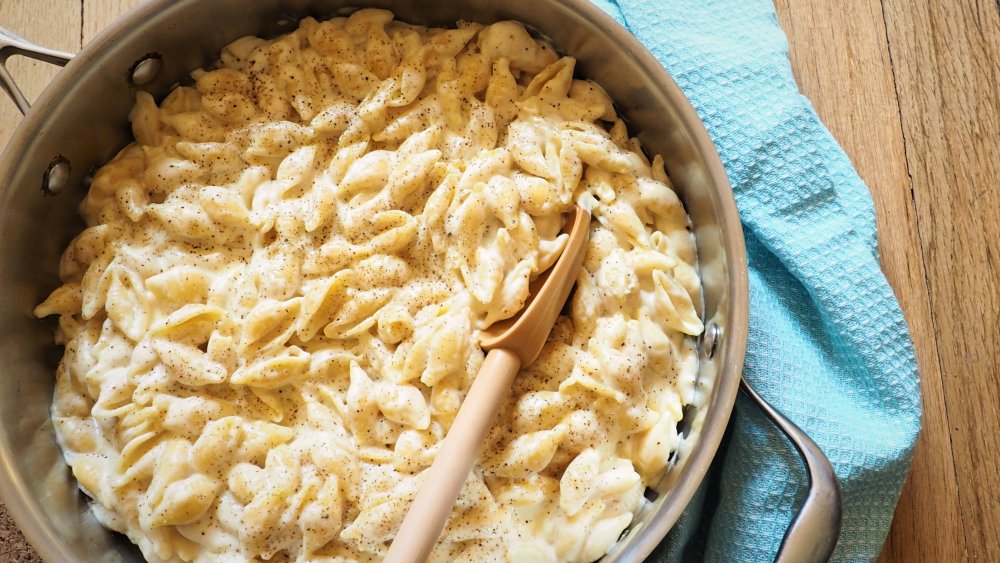
Ingredients
- 4 cups milk
- 2 cups water
- 1 teaspoon kosher salt
- 1/2 teaspoon garlic powder
- 1/8 teaspoon ground paprika
- 1 pound uncooked short pasta, like shells, elbows, or cavatappi
- 1 egg yolk (optional)
- 1 teaspoon Dijon mustard
- 4 ounces cream cheese, cut into 1/2-inch chunks
- 10 ounces freshly grated sharp cheddar
- 2 ounces freshly grated mozzarella cheese
- 1/4 cup freshly grated Parmesan cheese
- Freshly ground black pepper, to taste
Directions
- Start with a large, wide saute pan with tall sides. You can also use a large saucepan or a Dutch oven. Heat the milk, water, salt, garlic powder, ground paprika, and uncooked pasta over medium-high heat.
- When the mixture reaches a boil, reduce the heat to maintain a simmer. Cook the pasta for the time detailed on the package directions — usually 8 to 10 minutes — until it's al dente. Do not drain the cooking liquid.
- When the pasta is cooked, place the egg yolk and Dijon mustard in a small bowl. Add 1/4 cup of the hot cooking liquid to the egg yolk, whisking as you add to keep the yolk from scrambling. Add a second 1/4 cup of hot liquid, whisking until it's incorporated, before adding the warm egg-milk mixture back to the pot.
- Remove the pot from the heat. Working quickly to keep the milk from cooling down too much, stir the cream cheese into the pot. When it's fully incorporated, add the grated cheese one handful at a time. Stir constantly until the cheese is melted before adding the next handful of cheese.
- If the sauce is too thick, add water or milk one tablespoon at a time until it reaches the desired consistency.
- Taste the mac and cheese and season it with salt and black pepper, to taste.
